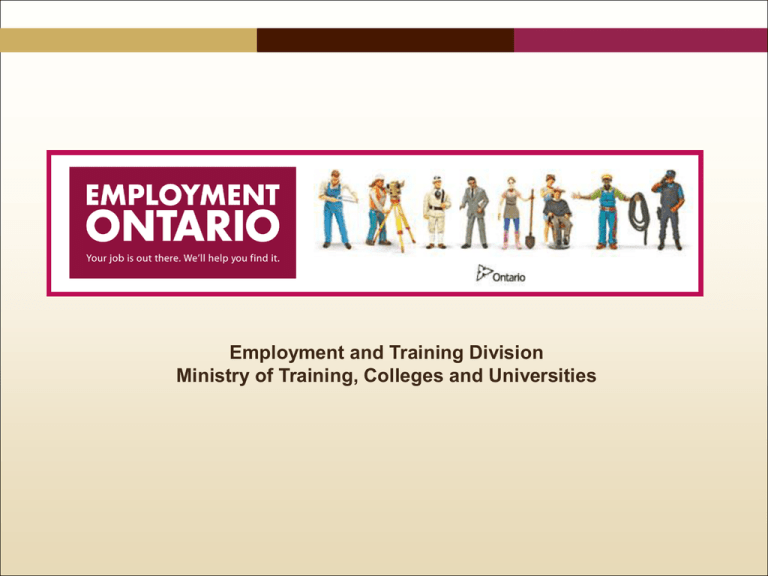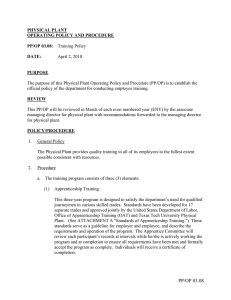Employment and Training Division Ministry of Training
advertisement

Employment and Training Division Ministry of Training, Colleges and Universities In this presentation • • • • • • Ontario’s Apprenticeship System Becoming an Apprentice Benefits and Financial Incentives for Apprentices Benefits and Financial Incentives for Employers/Sponsors The Ministry of Training, Colleges and Universities Steps to Apprenticeship Conclusion 2 Ontario’s Apprenticeship System 3 What is a skilled trade? • A skilled trade is an occupation that requires a specific skill or set of skills (e.g., special events coordinator, early childhood educator, hairstylist, plumber, electrician, brick and stone mason, auto body repairer, etc.). • Skilled trades people are involved in almost every aspect of Ontario’s economy and are in high demand in our rapidly changing workforce. 4 What are the four trade sectors? • • • • Industrial/Manufacturing Motive Power Service Construction 5 Industrial/Manufacturing • • • • • • Tool and Die Maker General Machinist Mould Maker Industrial Mechanic Millwright Industrial Electrician Welder 6 Motive Power • Automotive Service • • • • • Technician Truck and Coach Technician Agricultural Equipment Technician Heavy Duty Equipment Technician Auto Body Repairer Motorcycle Technician 7 Service • • • • • • • Cook/Chef Baker Hairstylist Early Childhood Educator Educational Assistant Developmental Services Worker Pool and Hot Tub and Spa Installer 8 Construction • • • • • • • Electrician General Carpenter Hoisting Engineer Plumber Steamfitter Refrigeration and Air Conditioning Systems Mechanic Brick and Stone Mason 9 What is an apprenticeship? It is a model of learning in which: • ninety per cent (90%) is on-the-job training under the direction of a qualified person, and • ten per cent (10%) is in-school training, that provides the theory to support the practical on-the-job training. 10 What is MTCU’s role in apprenticeship? The Ministry of Training, Colleges and Universities (MTCU) controls/administers Ontario’s Apprenticeship programs under the legislation of two acts: • Trades Qualification and Apprenticeship Act, R.S.O. 1990 (TQAA) • Apprenticeship and Certification Act, 1998 (ACA) 11 What are compulsory, voluntary, restricted and unrestricted trades? • By law, only registered apprentices and certified journeypersons can work in “compulsory” or “restricted” trades. • Apprenticeship training and certification are available but not required by law in “voluntary” or “non-restricted” trades. 12 Becoming an Apprentice 13 Who can become an apprentice? An individual must: • be 16 years of age or older • have an Ontario Grade 12 diploma or equivalent for most trades in the industrial/manufacturing, service and motive power sectors. A Grade 10 education is required for trades in the construction sector, and • provide proof of the required education. The individual must meet all three requirements to participate in the program. 14 How does someone become an apprentice? An applicant is required to: • find an employer/sponsor to hire and train him or her • contact the local MTCU Apprenticeship office to register, and • attend a meeting with the employer/sponsor and the employment training consultant (ETC) to review roles and responsibilities. 15 What requirements are there for employers? To train an apprentice, an employer must: • have the capacity to provide quality training • provide necessary equipment, materials, processes and facilities to create a learning environment • have the stipulated ratios for apprentices to journeypersons for the trade or occupation (when required), and • agree to allow the apprentice time off to attend the in-school training. Employers must meet all requirements to qualify. 16 How can an employer recruit an apprentice? An employer should take the following steps: 1. Assess business and training needs. 2. Review the apprenticeship training standard. 3. Identify appropriate journeypersons/trainers. 4. Review the entrance requirements for apprentices. 5. Identify an apprentice to recruit. 17 What are an apprentice’s responsibilities? An apprentice is responsible for: • following all lawful instruction • learning the skills of the trade as outlined in the training standard provided at the time of registration • attending the approved apprenticeship in-school training requirement • maintaining a record of competencies (i.e., skill sets) acquired, as outlined in the training standard, and hours worked, and • notifying the ministry of any changes to the training agreement, contract or personal information. 18 What are the employer’s/sponsor’s responsibilities in an apprenticeship? An employer is responsible for: • providing quality training and supervision • adhering to relevant legislation (i.e., ACA, TQAA) • maintaining communication with ministry staff, and • ensuring that the apprentice is aware of his/her responsibilities. 19 What is the cost to the apprentice? The cost to an apprentice includes: • a registration fee: $40 • classroom fees: they will vary, but are generally $50 per week for an eight-week (240 hour) period of instruction • an examination fee: $100. 20 What certification does an apprentice receive after completing the apprenticeship? After successfully completing the program requirements for a trade or occupation, an apprentice will receive one or both of the following certificates: • Certificate of Apprenticeship • Certificate of Qualification 21 What is the “Red Seal” Program? • The Interprovincial Standards Red Seal Program provides an interprovincial standard of excellence for the skilled trades that is recognized by industry. • In Red Seal trades, workers who successfully challenge a Red Seal trade examination receive a Certificate of Qualification with a distinctive red seal that is recognized across Canada. 22 Benefits and Financial Incentives for Apprentices 23 What financial incentives are available to apprentices? Ontario initiatives: • Loans for Tools • Classroom Training Subsidies and Supports • Apprenticeship Scholarship • Non-Red Seal Trade Benefit 24 Financial incentives for apprentices (continued) Federal initiatives: • Apprenticeship Incentive Grant (AIG) • Apprenticeship Completion Grant (ACG) • Tradesperson's Tools Deduction 25 Benefits and Financial Incentives for Employers/Sponsors 26 How do apprentices benefit employers/sponsors? 27 What financial incentives are available to employers/sponsors? Ontario initiatives: • Apprenticeship Training Tax Credit (ATTC) • Employer Signing Bonus • Employer Bonus Federal initiative: • Apprenticeship Job Creation Tax Credit 28 What are the steps to apprenticeship? The Ministry of Training, Colleges and Universities (MTCU) offers several programs for individuals interested in apprenticeships: • Ontario Youth Apprenticeship Program (OYAP) • Co-op Diploma Program (Co-op) • Pre-apprenticeship Training Program (Pre-app) 29 Ontario Youth Apprenticeship Program • The Ontario Youth Apprenticeship Program (OYAP) is the school-to-work transition program that offers students the opportunity to become an apprentice while attending high school and earning cooperative education credits. • To participate in OYAP students must: • be enrolled in school full-time • be at least 16 years of age, and • have completed Grade 10 and the 16 compulsory credits. 30 Co-op Diploma Program • The Co-op Diploma program allows participants, upon graduating from high school, to register as apprentices and obtain a college diploma at the same time. • It is an efficient, streamlined and flexible way to encourage postsecondary education and trade certification, and allow a broader range of young people to choose a career in the skilled trades. • It meets the evolving needs of employers and labour market needs. 31 Pre-apprenticeship Training Program The Pre-apprenticeship Training Program helps Ontarians: • gain trade-related theory and practical experience to become more marketable and have easier access to apprentice training and registration, and • bridge the gap between the skills they have and the skills employers want. 32 Tradesperson Certification 33 Who can Apply to Write Trade Exams? • Tradespersons from abroad • Tradespersons that have worked for numerous • years in the trade Completed apprentices 34 Step 1: Get Your Application Package Writing your • You can get this package from your nearest • apprenticeship office or have one mailed to you through the Employment Ontario Hotline. The package includes: • an Application for Certificate of Qualification form • an Affirmation of Skills form for your trade, and • the Ontario Apprenticeship Training Standard for your trade. 35 Step 2: Read the Apprenticeship Training Standard for Your Trade • As part of your application, you must prove that • • your experience as a skilled worker in your trade is substantially similar to the training that an Ontario apprentice receives. Review the skill sets described in the training standard. These are the skills you will be tested on during the certification exam. 36 Step 3: Get your Documents Together • Picture ID & SIN • Complete application For Certification of • • Qualification form Affirmation of Skills form Evidence of hours worked and skills used in your trade: • Letters from current or past Employers • Letters from Unions • Apprenticeship documentation Note that ministry staff may contact your references to confirm your work experience and skills. If they cannot contact any of your references, your application may be rejected. 37 Step 4: Submit Your Application • Once you have filled out the Application for Certificate of Qualification and Affirmation of Skills forms and included all the supporting documentation you have, submit your application in person or by mail to your local apprenticeship office. 38 Step 5: Approval of Application • Ministry Staff either in person or over the phone at • • will contact applicant Ministry will approve applicant and give information regarding Exam If application is not approved Ministry Staff will: • confirm that you are applying for certification in the correct trade and have the number of hours needed for your trade; • offer guidance on filling out the application form and collecting supporting documents • Provide information on Apprenticeship Programs 39 Questions? 40 Contact Information To find the nearest Apprenticeship office: 1. Contact the Employment Ontario Hotline • Toll-free: 1-800-387-5656 • TTY: 1-866-768-1157 • Toronto: 416-326-5656 2. Contact an Employment Ontario office in your area The list of these offices is available at www.edu.gov.on.ca/eng/tcu/employmentontario/training/ 3. Visit the ministry website at www.edu.gov.on.ca/eng/tcu/employmentontario/training/ 41
